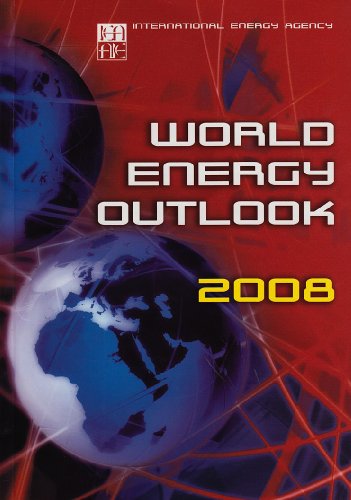

Most ebook files are in PDF format, so you can easily read them using various software such as Foxit Reader or directly on the Google Chrome browser.
Some ebook files are released by publishers in other formats such as .awz, .mobi, .epub, .fb2, etc. You may need to install specific software to read these formats on mobile/PC, such as Calibre.
Please read the tutorial at this link: https://ebookbell.com/faq
We offer FREE conversion to the popular formats you request; however, this may take some time. Therefore, right after payment, please email us, and we will try to provide the service as quickly as possible.
For some exceptional file formats or broken links (if any), please refrain from opening any disputes. Instead, email us first, and we will try to assist within a maximum of 6 hours.
EbookBell Team

5.0
40 reviews
ISBN 10: 9264045600
ISBN 13: 9789264045606
Author: International Energy Agency; International Energy Agency Staff
Annotation "World Energy Outlook 2008 draws on the experience of another turbulent year in energy markets to provide new energy projections to 2030, region by region and fuel by fuel, incorporating the latest data and policies."
PART A - GLOBAL ENERGY TRENDS TO 2030
Highlights
Government policies and measures
Population
Economic growth
Oil prices
Natural gas prices
Technology
Highlights
Primary energy mix
Regional trends
Sectoral trends
Resources and production prospects
Inter-regional trade
Trends by region and energy source
Highlights
Trends in primary oil demand
Regional trends
Sectoral trends
Implications for spending on oil
Production
Inter-regional trade
Highlights
Demand
Regional trends
Sectoral trends
Production
Inter-regional trade
Highlights
Demand
Reserves and production
Inter-regional trade
Coal prices and supply costs
Coal investment
Highlights
Electricity demand
Outlook for electricity generation
Trends in coal-fired generation
Trends in gas-fired generation
Trends in nuclear power
Trends in CO2 capture and storage
New capacity and investment needs in infrastructure
Trends in construction costs
Cost and efficiency assumptions
Electricity prices
Highlights
Global trends in the use of renewable energy
Renewables for electricity
Hydropower
Wind power
Solar photovoltaics
Geothermal power
Biofuels
Renewables for heat
Traditional biomass
Investment in renewable energy
Highlights
Why focus on cities?
Current and projected energy use in cities
Background
Reference Scenario projections
Background
Reference Scenario projections
Background
Reference Scenario projections
Background
Reference Scenario projections
PART B - OIL AND GAS PRODUCTION PROSPECTS
67. TURNING OIL RESOURCES INTO RESERVES
68. Highlights
69. Understanding production patterns and trends
70. The importance of size
71. Regional differences
72. Standard production profiles
73. Focus on giant fields
74. Approach and definitions
75. Results of the analysis
76. The impact of field age and maturity
77. Trends in observed decline rates
78. Deriving an estimate of the average global observed decline rate
79. Estimating historical trends
80. Long-term prospects for natural decline rates
81. Highlights
82. Summary of projections in the Reference Scenario
83. Crude oil output at existing fields
84. Contribution of new fields to crude oil production
85. Enhanced oil recovery (EOR)
86. Natural gas liquids (NGLs)
87. Non-conventional oil
88. Crude oil quality
89. Non-OPEC production
90. OPEC production
91. Sensitivity of oil output to decline rates
92. Highlights
93. Conventional gas
94. Non-conventional gas
95. Gas production prospects
96. OECD North America
97. OECD Europe
98. Eastern Europe/Eurasia
99. Non-OECD Asia
100. Middle East
101. Africa
102. Latin America
103. Highlights
104. Recent investment trends and near-term outlook
105. New upstream projects
106. Capital-cost trends
107. Trends in upstream activity
108. Implications for oil-production capacity
109. Outlook for investment to 2030
110. Depletion policies of resource-rich countries
111. Profitable opportunities for international companies to invest
112. Availability of people and equipment
113. Highlights
114. The emergence of a new world order for oil
115. The resurgence of the national oil companies
116. International oil companies in profitable retreat
117. Implications for future investment and supply
118. Towards a more efficient industry
119. Strengthening strategic partnerships
120. Highlights
121. Overview
122. Resources and reserves
123. Oil and gas production and exports
124. Oil refining
125. Household energy access in sub-Saharan African countries
126. Cooking practices
127. Electricity access
128. Projected trends in access to modern energy services
129. Quantifying the costs involved in expanding access
130. Managing revenues from oil and gas
PART C - THE ROLE OF ENERGY IN CLIMATE POLICY
131. Highlights
132. Overview
133. Regional trends
134. Trends per capita and per unit of GDP
135. Sectoral trends
136. Projected trends in overall greenhouse-gas emissions
137. Long-term greenhouse-gas concentrations and average global temperature
138. Hydropower
139. Other renewable energy systems
140. Projected trends in local and regional air pollution
141. Highlights
142. Co-ordinated global action to address climate change
143. Environmental and societal effects of different stabilisation levels
144. Practical considerations in reducing emissions
145. Climate scenarios modelled in WEO-2008
146. Participation
147. Principles for allocating responsibilities
148. Policy mechanisms
149. Cap-and-trade systems
150. Sectoral agreements
151. National policies and measures
152. Highlights
153. Modelling approach
154. Energy prices
155. Primary energy demand
156. Energy-related CO2 emissions
157. Emissions of gases other than energy-related CO2
158. Power generation
159. Industry
160. Transport
161. Buildings and other sectors
162. Power generation
163. Industry
164. Transport
165. Buildings and other sectors
166. Energy security
167. Local and regional air pollution
168. Highlights
169. Investment implications of the 550 Policy Scenario
170. Regional implications of the 550 Policy Scenario
171. Implications of the 550 Policy Scenario for the electricity sector
172. Implications of the 550 Policy Scenario for the transport sector
173. Costs and benefits of the 550 Policy Scenario
174. Investment implications of the 450 Policy Scenario
175. Replacement of capital stock in the power sector
176. Carbon markets
177. Technology diffusion
178. Implications for policy
world energy outlook pdf
world energy outlook 2021 data
world energy outlook eia
world energy outlook 2022 extended dataset
world energy outlook 2008
Tags: International Energy Agency, International Energy Agency Staff, World, Energy